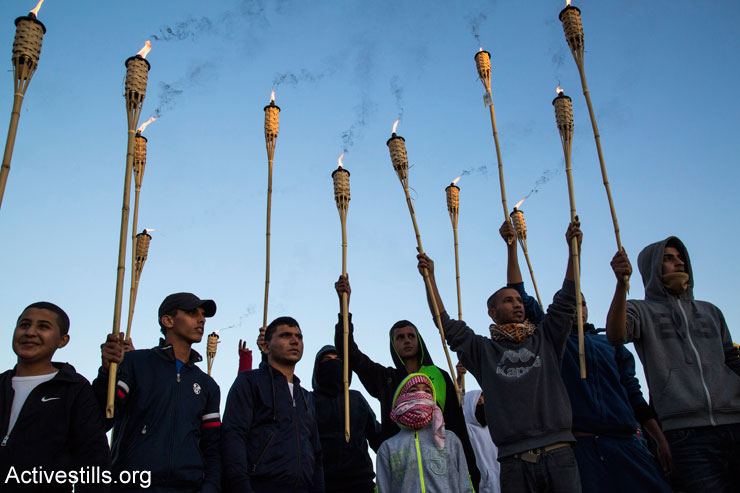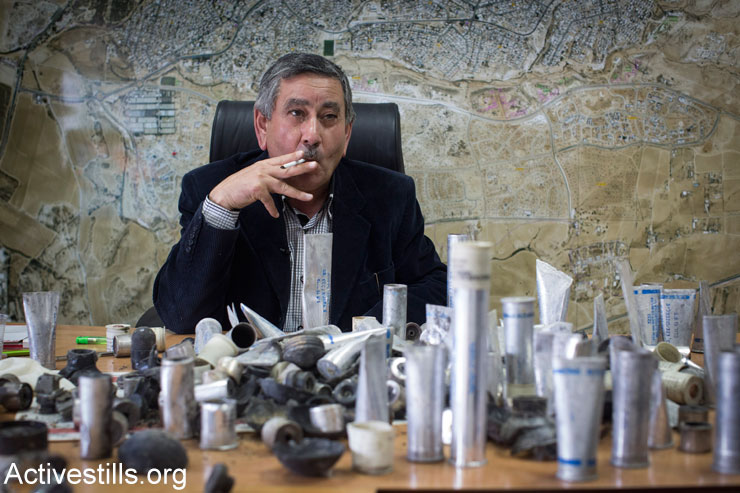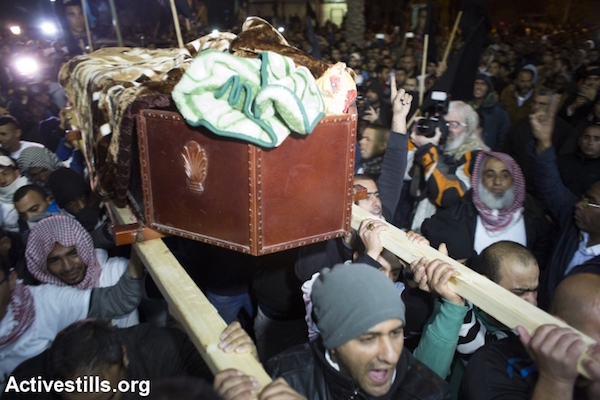Despite DNA evidence and a failed lie detector test, the police officer who allegedly shot and killed Sami al-Jaar will most likely not face criminal charges.
By John Brown* (translated from Hebrew by Ofer Neiman)

New and disturbing details on the deadly shooting of a Bedouin man by an Israeli police officer have come to light, after +972’s Hebrew site Local Call reported that the Police Investigations Department (PID) intends to close the case on grounds of “insufficient evidence.” According to the findings, the officer in question was found to be lying in a polygraph test, and a DNA test concluded he fired the deadly shots.
Some background: on January 14, 2014 during a police raid on a school where drugs were allegedly being sold in “Neighborhood 26” of the southern Bedouin township of Rahat, 22-year-old Sami al-Jaar was shot dead as he returned home from work. The man’s father, who was the one to call the police over the suspicious activity in the neighborhood in the first place, saw an officer beating his son before he heard numerous shots being fired.
Following the incident, two of the family’s relatives testified that one of the officers aimed his weapon directly at Sami, contrary to the police version of events at the time, according to which the shots were fired into the air with the objective of dispersing the crowd that had gathered.
One of the officers who took part in the raid was arrested a month after admitting to being involved in the shooting, but was released to house arrest after just one day. He has not been arrested again, and his interrogation by the Police Investigations Department was conducted entirely in his home.
Following 11 months of investigation, the head of the Police Investigations Department, Uri Carmel, notified the al-Jaar family on December 22 that there was insufficient evidence to indict the officer, although Carmel made it clear he knew the officer had lied during his testimony. Carmel had reportedly told the police that he could not convince State Attorney Shai Nitzan that there was sufficient evidence to indict the officer in question.
It is hard to accept this position, since Carmel himself said the officer undergone a polygraph test. At first, the officer was asked whether he had shot in the direction of anyone: he responded that he had not, in line with his narrative about having fired only in the air, like his fellow officers. According to the polygraph, he was lying. After he realized he had been caught in a lie, and following consultations with his lawyer, the officer changed his account, claiming he had fired in the air, and that another bullet went off as he put his weapon back in its holster. The officer also claimed that he had been afraid at first, and had therefore lied.

Then the officer was asked whether he shot in the direction of Sami al-Jaar. The officer denied this claim and was found to be speaking the truth. The explanation for this is simple: the officer did not know al-Jaar, and therefore had no idea what he looked like. This question should not have been asked without checking in advance whether the officer knew al-Jaar’s identity.
This question is redundant for another reason. A bullet matching the officer’s weapon — with Sami’s DNA on it — was found at the scene of the shooting. While polygraph tests are not admissible in court, this test proves conclusively that the officer in question had indeed fired it, hitting al-Jaar.
Questioned in the comfort of his own home
Did the officer accidentally discharge his weapon, as he claimed in his modified account? In view of the eye witness testimonies from al-Jaar’s family members, that is hard to believe. Furthermore, the fact that there had been a previous confrontation between the officers and al-Jaar casts doubts on this account, as well as the fact that the officer’s claims changed as the evidence was uncovered.
Without the full investigation records — which are supposed to be published soon — one cannot conclude whether the prospects of indictment for manslaughter are reasonable. At the very least, however, it is clear this case involves negligence that brought about the death of an innocent person, and that justice should be served. Even an accidental firing of a gun can lead to a manslaughter conviction, as can be seen by previous cases. It is hard to understand how this time around, the police decided there was not enough evidence to indict.

A person suspected of manslaughter who is not a police officer would never receive such treatment. He or she would never be interrogated in the comfort of their home, something rather different from the normal police interrogations under caution. An ordinary suspect would not be backed by the district commander, even though the officer in question had clearly appeared to have obstructed investigative procedures. Just like other investigations involving suspicions of police officers killing citizens, this case was prone to failure.
The announcement from the Justice Ministry’s Police Investigations Department, according to which a decision on the case “has been delayed,” seems like an attempt to calm things down in the face of injustice. Chances are that this will not bring about any major change in the decision.
The Police Investigations Department sent the following response to our query about the case:
The head of the Police Investigations Department, his deputy, and the attorney in charge of the case, held a meeting with Mr. Khaled al-Jaar — the father of the late Sami al-Jaar, who was shot to death during police activity in Rahat in January 2015 — along with the father’s attorney. The purpose of the meeting was to notify the two of the evidential status of the case. At the end of the meeting, the father’s attorney was offered a copy of the investigation material so that he could submit his arguments, if deemed appropriate, as part of the procedures for appealing the decision in the case.
*John Brown is the pseudonym of an Israeli academic and a blogger. A version of this article was first published in Hebrew on Local Call, where he is a blogger. Read it here.

